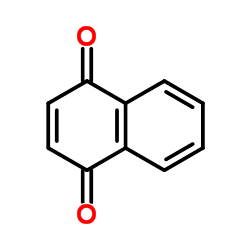1,4-naphthoquinone

1,4-naphthoquinone structure
|
Common Name | 1,4-naphthoquinone | ||
|---|---|---|---|---|
| CAS Number | 130-15-4 | Molecular Weight | 158.153 | |
| Density | 1.3±0.1 g/cm3 | Boiling Point | 297.9±40.0 °C at 760 mmHg | |
| Molecular Formula | C10H6O2 | Melting Point | 119-122 °C(lit.) | |
| MSDS | Chinese USA | Flash Point | 111.2±24.3 °C | |
| Symbol |



GHS06, GHS08, GHS09 |
Signal Word | Danger | |
|
Photosensitizing properties of compounds related to benzophenone.
Acta Derm. Venereol. 93(1) , 30-2, (2013) Benzophenone is a phototoxic compound with absorption maxima in the ultraviolet A (UVA) and ultraviolet B (UVB) range. Many benzophenone derivatives are known to be photosensitizing. On the other hand, 2-hydroxy-4-methoxybenzophenone is used as a photoprotect... |
|
|
Combined experimental and simulation studies suggest a revised mode of action of the anti-Alzheimer disease drug NQ-Trp.
Chemistry 21 , 12657-66, (2015) Inhibition of the aggregation of the monomeric peptide β-amyloid (Aβ) into oligomers is a widely studied therapeutic approach in Alzheimer's disease (AD). Many small molecules have been reported to work in this way, including 1,4-naphthoquinon-2-yl-L-tryptoph... |
|
|
Posttranslational Regulation of Human DNA Polymerase ι.
J. Biol. Chem. 290 , 27332-44, (2015) Human DNA polymerases (pols) η and ι are Y-family DNA polymerase paralogs that facilitate translesion synthesis past damaged DNA. Both polη and polι can be monoubiquitinated in vivo. Polη has been shown to be ubiquitinated at one primary site. When this site ... |
|
|
Genotoxic and inflammatory effects of organic extracts from traffic-related particulate matter in human lung epithelial A549 cells: the role of quinones.
Toxicol. In Vitro 27(2) , 922-31, (2013) Traffic-related particulate matter (PM) is associated with adverse health effects. Quinones present in the traffic-related PM are hypothesized to contribute to these harmful effects through reactive oxygen species (ROS) generation. However, the impacts of the... |
|
|
Bioactivities of simplified adociaquinone B and naphthoquinone derivatives against Cdc25B, MKP-1, and MKP-3 phosphatases.
Bioorg. Med. Chem. 17 , 2276-81, (2009) Some simplified adociaquinone B analogs and a series of 1,4-naphthoquinone derivatives were synthesized and tested against the three enzymes Cdc25B, MKP-1, and MKP-3. Cdc25B and MKP-1 in particular are enzymes overexpressed in human cancer cells, and they rep... |
|
|
Chromatographic behavior of small organic compounds in low-temperature high-performance liquid chromatography using liquid carbon dioxide as the mobile phase.
J. Sep. Sci. 38 , 2381-6, (2015) Low-temperature high-performance liquid chromatography, in which a loop injector, column, and detection cell were refrigerated at -35ºC, using liquid carbon dioxide as the mobile phase was developed. Small organic compounds (polyaromatic hydrocarbons, alkylbe... |
|
|
2-Chloro-1,4-naphthoquinone derivative of quercetin as an inhibitor of aldose reductase and anti-inflammatory agent.
J. Enzyme Inhib. Med. Chem. 30(1) , 107-13, (2015) The ability of flavonoids to affect multiple key pathways of glucose toxicity, as well as to attenuate inflammation has been well documented. In this study, the inhibition of rat lens aldose reductase by 3,7-di-hydroxy-2-[4-(2-chloro-1,4-naphthoquinone-3-ylox... |
|
|
S-nitrosoglutathione covalently modifies cysteine residues of human carbonyl reductase 1 and affects its activity.
Chem. Biol. Interact. 202(1-3) , 136-45, (2013) Carbonyl reductase 1 (CBR1 or SDR21C1) is a ubiquitously-expressed, cytosolic, monomeric, and NADPH-dependent enzyme. CBR1 participates in apoptosis, carcinogenesis and drug resistance, and has a protective role in oxidative stress, cancer and neurodegenerati... |
|
|
Forecasting cell death dose-response from early signal transduction responses in vitro.
Toxicol. Sci. 140(2) , 338-51, (2014) The rapid pharmacodynamic response of cells to toxic xenobiotics is primarily coordinated by signal transduction networks, which follow a simple framework: the phosphorylation/dephosphorylation cycle mediated by kinases and phosphatases. However, the time cou... |
|
|
Singlet oxygen production by pyrano and furano 1,4-naphthoquinones in non-aqueous medium.
Photochem. Photobiol. Sci. 11(7) , 1201-9, (2012) The influence of ring size on the photobehaviour of condensed 1,4-naphthoquinone systems, such as pyrano- and furano-derivatives (1 and 2, respectively) has been investigated. The absorption spectra for both families of naphthoquinones reveal clear difference... |